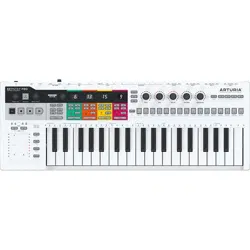Loading ...
Loading ...
Loading ...

The Tempo/Fine knob sets the tempo from 30-240 beats per minute (BPM). As you turn this
knob, the BPM value is automatically rounded off to the nearest whole number and shown
on the KeyStep Pro's OLED display. Holding down 'Shift' while turning this knob gives you
finer BPM control by switching off the whole-number rounding.
The Tap Tempo/Metronome button lets you set the tempo by tapping on this button in time
with the beat you want or are hearing.
To enable or disable KeyStep Pro's built-in Metronome, hold down 'Shift' while pressing the
Tap Tempo/Metronome button.
♪: You can change Metronome time division by holding the Tap Tempo button and pressing one of
the time division keys (value printed above the keyboard).
Turning the Swing/Offset knob lets you adjust the amount of swing or 'shuffle' feel in your
sequences. It affects either the entire project (all four tracks at once) or only the selected
sequencer/arpeggiator, leaving the others unchanged. Holding down the 'Shift' button while
turning the Swing/Offset knob lets you adjust the timing offset for a track.
♪: If the KeyStep Pro is externally synchronized, the master tempo will be determined by an external
clock source and the Tempo/Fine knob and the Tap Tempo button are ignored.
Swing introduces a shuffle feel to the active sequence or arpeggio. If you've listened to a
variety of musical genres (it's unlikely that you haven't), you have heard swing. It's when
musicians play just before or just after the beat. This is very often heard in jazz and Latin
American music. It evokes a feeling of freedom, of not being forced into a fixed, grid-like
rhythm. It is particularly effective when you mix 'straight' notes with 'swung' notes.
25 different settings are available, ranging from fully counterclockwise (no swing, or 50%)
through increasing amounts of swing (51-74%) to fully clockwise (maximum swing, or 75%).
What the Swing setting does is shift the timing of the notes in a sequence, making the first
note of a pair longer and the second note shorter. Assuming the time division is set to 1/8,
here's what will happen:
• With Swing set to 50%, each note gets equal time, resulting in a 'straight 1/ 8th
note' feel
• As the Swing value is increased above 50% the first 1/8th note is held longer and
the second is played later and shorter. You'll notice that the sequence starts to
'shuffle' a bit and hopefully sounds less mechanical to your ear
• The maximum Swing setting is 75%, at which point the 1/8th notes sound more
like a 1/16th-note figure than 'shuffled' 1/8th notes.
♪: Each sequence can have its own Swing setting.
Turning the Swing knob will apply swing to all sequences and arpeggios simultaneously.
Use 'Shift' + Swing to apply swing to the arpeggio on the active track only. When you record
an arpeggio and quantize is off, Swing is recorded in the sequencer.
Turning or pressing the Swing/Offset knob will display the global and current track offset
values.
Arturia - User Manual Keystep Pro - KeyStep Pro Overview 33
Loading ...
Loading ...
Loading ...
